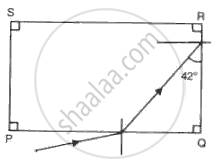Advertisements
Advertisements
Question
(i) Define critical angle.
(ii) State one important factor which affects the critical angle of a given medium.
Solution
(i) The angle of incidence for which the angle of refraction is 90o is called critical angle.
`"_1 mu _2 = (sin i_c)/(sin (90^circ))`
`therefore (mu_2)/(mu_1) = (sini_c)/(1)`
` therefore 1/mu = sini_c " If " mu_2 = 1 mu_1 = mu`
` therefore i_c = sin^(-1) (1/mu)`
(ii) Relative refractive of the medium `("_1 mu_2)`1
APPEARS IN
RELATED QUESTIONS
Name the factors affecting the critical angle for the pair of media.
A light ray does not bend at the boundary in passing from one medium to the other medium if the angle of incident is ______.
Prove the statement.
A rainbow is the combined effect of the refraction, dispersion, and total internal reflection of light.
Swarali has got the following observations while doing an experiment. Answer her questions with the help of observations.
Swarali observed that the light bent away from the normal, while travelling from dense medium to rarer medium. When Swarali increased the values of angle of incidence (i), the values of angle of refraction (r) went on increasing. But at a certain angle of incidence, the light rays returned into the dense medium.
So, Swarali has some questions. Answer them –
a) Name this certain value of ‘i ’. What is the value of ‘r’ at that time ?
b) Name this process of returning of light in dense medium. Explain the process.
Plot a graph between
Angle of incidence versus angle of refraction.
(a) A ray of monochromatic light enters glass PQRS as shown in the fig. Complete the path of ray till it emerges from the glass. (Critical angle of glass is 420).

(b) Draw diagram of a prism periscope.
(c) What are the advantages of total internal reflecting prism over plane mirror?
Make the correct choices for each of the following :
Total Internal reflection takes place when
(where ∠i = angle of incidence, ∠r = angle of refraction, ∠C = critical angle)
Name the principle on the basis of which optical fibres work.
A ray of light is incident on a glass surface at an angle of 50° with the corresponding angle of refraction 30°. Find the value of the R.I. of glass.
A given ray of light suffers minimum deviation in an equilateral prism P. Additional prism Q and R of identical shape and of the same material as P are now added as shown in the figure. The ray will now suffer ______.

